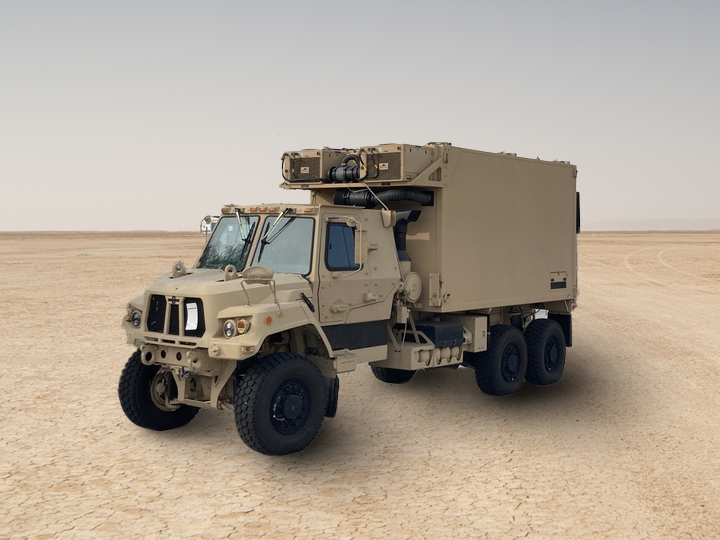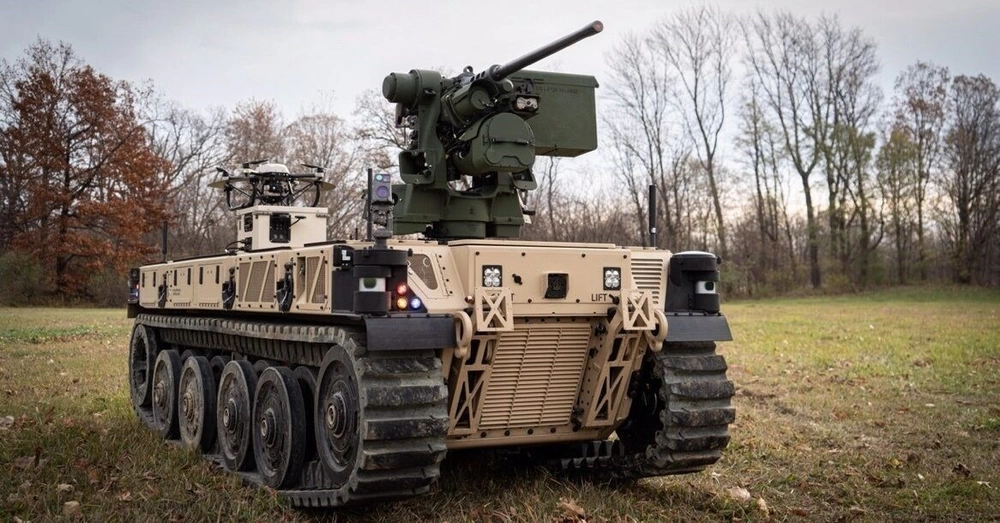
To stay competitive in the future fight against rapidly evolving threats and sophisticated adversaries, the Department of Defense is embracing and celebrating software-led hardware, as seen in the Army’s most recent modernization programs. Palantir is proud to take part in and lead this wave of change, as seen through the most recent TITAN program acquisition and the Robotic Combat Vehicle (RCV) down select.
A key differentiator needed by the Department of Defense’s new systems, powered by emerging technologies, is enhanced modularity, openness, and flexibility. As software becomes increasingly central to achieving overmatch, we at Palantir believe that this kind of modular, open software will be a critical advantage that enables future ground, air, maritime, and space capabilities to achieve — and maintain — superiority.
But, understanding how to observe or measure modularity and openness of a system can seem like both a technical and subjective challenge. In this post, we’ll explore one important approach, MOSA, and provide examples of how Palantir designs solutions that are based on industry best practices and influenced by decades of hands-on experience.
About MOSA
Before unpacking the two aforementioned programs, it’s important to understand why Modular Open Systems Approach (MOSA) is so critical for future programs. MOSA enables components of complex systems to be competed separately to procure affordable, adaptable, and capable systems in a rapidly evolving threat environment, and enables these systems to continuously harness technological innovation to remain competitive against peer adversaries.
At Palantir, we implement MOSA principles into our government solutions from the foundation up. Our software offerings, including those implemented in TITAN and RCV, are comprised of multiple capability modules, which are highly cohesive, loosely coupled, extensible, interoperable, and fully severable. This ensures that we can augment existing systems and enable outcomes today in an end-to-end solution, a highly specific capability, or anything in between.
The SDSI Methodology — Palantir’s Approach to MOSA
Palantir solutions are built upon MOSA frameworks to provide capabilities that enable deployment of innovative technology more easily, cost effectively, and rapidly across complex Army solution ecosystems.
Palantir manages the complexity of the design, management, and upgrades through a methodology we have developed called Software Defined Systems Integration (SDSI), which is an implementation of MOSA principles. The SDSI methodology helps identify key system architecture components, develop customer-owned key system interfaces and data specifications, and manage the complexity of system-of-systems in code.
With SDSI, users can adapt and enhance modular systems in four ways:
1. Swap: Exchanging the functionality of one component with a new component
Systems can dynamically swap components, including hardware components, software packages, and algorithms. We have extensively swapped in and out various AI models as part of the TITAN program to ensure optimal performance in any operating condition. In contrast to legacy systems that can only be updated during design phases, SDSI enables Swap to be performed on the system continuously, even during system runtime.
2. Extend: Adding functionality by modifying an existing component and/or by introducing a new component
Modern hardware is composed of solutions from dozens of suppliers, many of whom use APIs and system interfaces to add new functionality to the system (e.g., new algorithms or domain specific analytic tools.)
SDSI enables system capabilities to mature and broaden use cases. Ultimately, this gives users the ability to add best-of-breed capabilities to the solution as they evolve — at low cost and high speeds — without jeopardizing the existing capabilities.
3. Import: Integrating data from another location or system
Utilizing flexible data integration tools that are compliant with both government and industry data specifications allows for ingestion and processing of data in nearly any format. SDSI upholds the quantity and variety of data that can be processed in the system, to ultimately build powerful solutions for the battlefield.
4. Export: Sending data from one system to another location in correct messaging formats
SDSI allows systems to be rapidly configured to send data and information to effectors accurately, quickly and efficiently. To be successful, users need to derive insights and come to conclusions, as well as send information out to other systems to enable a full intelligence and targeting lifecycle.
These concepts are based on Palantir’s experience designing and developing modular and open systems for our customers, and are in alignment with both government and enterprise best practices and standards. We have implemented and utilized government, open source, and commercial standards and interfaces, and developed program-specific APIs and data models for the government. As a result, all key components and interfaces allow users to leverage and extend Palantir’s software for the full lifecycle of the program.
Introducing TITAN
TITAN is the Army’s next generation deep-sensing intelligence ground station enabled by Artificial Intelligence and Machine Learning — and represents a first of its kind modernization program. With the top-line objective of increasing the Army’s ability to see farther on the battlefield and make decisions quicker, TITAN aims to replace multiple legacy tools and systems to deliver increased capability while also reducing complexity and timelines for the operator.
The TITAN program illustrates how Palantir has designed and delivered an integrated hardware and software system for the Army intelligence community. It is designed to field a new system as quickly as possible while maintaining the ability to adapt for continued relevance in the years to come. In its current form, TITAN connects to dozens of data sources and systems across the space, air, land, and maritime domains. It connects across multiple echelons of the Army and spans across Top Secret, Secret, Coalition, and unclassified network environments.
The Palantir TITAN system incorporates components and solutions from dozens of companies and government agencies to include Artificial Intelligence, Data Management, Data Correlation, Intelligence Analysis, Geospatial Analysis, Communications, Power Management, and many more.

Key highlights from TITAN demonstrations include:
- Showcased the modularity of key components such as AI detection models, sensor fusion algorithms, map components, domain-specific GOTS and COTS tools, and data integration logic.
- Conducted and documented trade studies of the relative performance and cost of dozens of hardware and software subcomponents
- Developed an implementation prototype based on our open design that reduced timelines for configuration, setup, operations, management and tear-down.
- Increased the range of detection and identification over legacy systems while also reducing complexity and cognitive burden for the end-user.
- Collaborative and rapidly iterative test-fix-test processes with the Army and contract partners.
Palantir’s work on the TITAN program is a successful example of “Software Pathways” for program acquisition and execution. As the software prime, we look forward to continuing our efforts in support of Army users worldwide.
The Next Frontier: RCV
Following a competitive Commercial Solutions Opening (CSO) down-select process, Palantir has been selected as a software system integrator to support the Ground Vehicle Autonomous Pathways (GVAP) project to prototype the integration of disparate hardware and software technologies, to include safety-critical software, for the Robotic Combat Vehicle (RCV) program.
Through the U.S. Army’s partnership with the Defense Innovation Unit (DIU), Palantir and others will prototype autonomous software and processes to adapt uncrewed vehicle technology to a range of diverse and challenging military environments. The effort will establish a capability for rapid integration of autonomous functionality and payloads into ground combat vehicles. Notably, this program is the first Army program to separate hardware and software acquisition pathways and the first to employ a software integrator.
Palantir’s approach, leveraging Software Defined Systems Integration, will ensure effective performance and stronger reliability — across both hardware and software — than traditional approaches. This shift from disconnected and isolated, installations will expand the performance envelope of the overall system, and allow for rapid innovation as the system evolves.
Palantir’s solution bridges the gap between third-party software and hardware prototypes, ensuring the integration of best of breed capabilities and future scalability of the RCV program with a modular, severable software architecture. Leveraging a suite of Palantir operating systems, the SDSI approach gives the RCV program visibility into prototyping efforts and flexibility as the battlefield, and ensuing requirements, continue to evolve.

A Powerful, Integrated Hardware & Software System
As the first software-led prime, Palantir demonstrates how dozens of hardware and software components — representing the best of breed capabilities from commercial industry, government, and academia — can be quickly integrated, tested, and evaluated to reduce sensor to shooter workflow timelines in future missions. Palantir’s proven SDSI approach to software solutioning enables true modularity, enabling resulting in unparalleled flexibility, scalability, and visibility into efforts from prototyping through to production.
Learn more about Palantir’s defense work, the RCV down-select, and how we’re working to collaboratively develop open standards and best practices across government organizations through a principal membership with the The Open Group’s SOSA Consortium.
Implementing MOSA with Software Defined Systems Integration was originally published in Palantir Blog on Medium, where people are continuing the conversation by highlighting and responding to this story.
